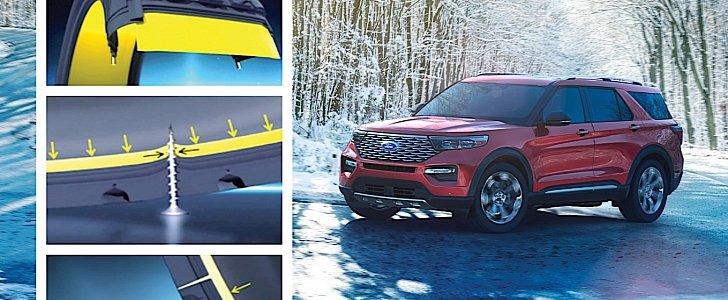Launched with great fanfare at the beginning of the year, Ford’s new star SUV, the 2020 Explorer, is getting all the attention as the centerpiece of the carmaker’s success in the coming years.
The car has been fitted from the get-go will all the features that would draw a prospective buyer to the nameplate and away from the competition, but Ford is taking things one step further by making the Explorer the first ever "SUV in the world" to use Michelin Selfseal tires.
The technology will come as standard on the Platinum and Limited Hybrid four-wheel-drive models and will be available as an option for the Limited two-wheel-drive and four-wheel-drive trims. All tires are sized 255/55R-20.
According to Michelin, the natural rubber sealant used in the tires is capable of sealing 90 percent of tread punctures up to a quarter-inch in diameter. This, in turn, slows the rate at which air pressure drops by less than 15 pounds per square inch per week, insuring the car keeps on the road and moving.
“The all-new Explorer is designed to help our customers feel unstoppable and worry-free,” said in a statement Craig Patterson, Explorer marketing manager. “The availability of these new Michelin Selfseal tires is another great example of that.”
The 2020 Ford Explorer sells in the U.S. starting at $33,000 and is a drastically redesigned version of one one of the most succesful Ford cars ever, built on an all-new rear-wheel-drive architecture.
The car is lighter and uses more powerful engines that the version preceding it and offers the greatest number of trim levels ever is available for the nameplate: standard, XLT, Limited, Limited Hybrid, ST and Platinum.
The base, XLT, and Limited models use a 2.3-liter engine capable of developing 300 horsepower and 310 lb.-ft. of torque, and a 3.0-liter turbocharged EcoBoost V6 has been deployed in the Platinum.
This bigger engine develops 365 horsepower and 380 lb.-ft. of torque.
The technology will come as standard on the Platinum and Limited Hybrid four-wheel-drive models and will be available as an option for the Limited two-wheel-drive and four-wheel-drive trims. All tires are sized 255/55R-20.
According to Michelin, the natural rubber sealant used in the tires is capable of sealing 90 percent of tread punctures up to a quarter-inch in diameter. This, in turn, slows the rate at which air pressure drops by less than 15 pounds per square inch per week, insuring the car keeps on the road and moving.
“The all-new Explorer is designed to help our customers feel unstoppable and worry-free,” said in a statement Craig Patterson, Explorer marketing manager. “The availability of these new Michelin Selfseal tires is another great example of that.”
The 2020 Ford Explorer sells in the U.S. starting at $33,000 and is a drastically redesigned version of one one of the most succesful Ford cars ever, built on an all-new rear-wheel-drive architecture.
The car is lighter and uses more powerful engines that the version preceding it and offers the greatest number of trim levels ever is available for the nameplate: standard, XLT, Limited, Limited Hybrid, ST and Platinum.
The base, XLT, and Limited models use a 2.3-liter engine capable of developing 300 horsepower and 310 lb.-ft. of torque, and a 3.0-liter turbocharged EcoBoost V6 has been deployed in the Platinum.
This bigger engine develops 365 horsepower and 380 lb.-ft. of torque.


